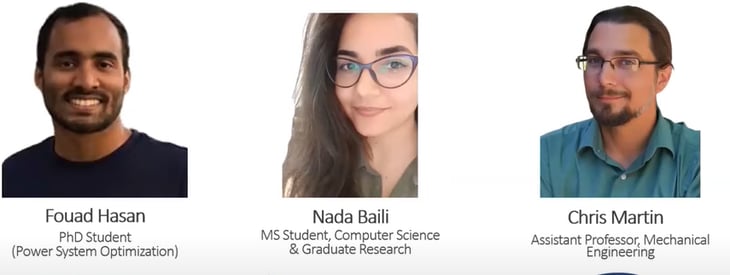Universities and school districts around the nation are struggling to find the most effective ways to continue their instruction amidst an ongoing global pandemic. Whether they open physical locations, move to online learning/NTI (non-traditional instruction), or a blended model of the two, this year's back to school season will be unique to say the least. Going back to school was a hot topic during July's "Back to Business with AI" event hosted by the AI Innovation Consortium (AIIC). In a special lunch panel comprised of PhD students and educators, we learned about the impact of Artificial Intelligence (AI) in higher education and the future workforce.
Meet the Panel of AI Students and Educators
Because AI is such a groundbreaking field, the students who study it and the professors who teach it are often the leading experts in their industry. With new information and discoveries coming out all the time, these PhD students have first- hand knowledge about the capabilities and use cases of Artificial Intelligence. The panel discussion included two students, Nada Bali, an MS student in Computer Science and Graduate Research at the University of Louisville, and Fouad Hasan, a PhD student at Louisiana State University, as well as Chris Martin, Assistant Professor of Mechanical Engineering at Penn State University. Each panelist was invited to speak due to their close work with AI in various projects.

How Can AI be Used to Open Schools Safely?
The first question posed to the panel was, "How do you see AI helping us get back to school safely?" You can catch the panelists' full answers in the recording above, or check out the recap below.
Chris Martin shared his observation that thermal imaging technology has been in high demand since the start of the pandemic to monitor elevated temperatures in a common areas like lobbies or classrooms. The technology uses sensors to alert officials of temperature spikes on individuals, signaling possible fever, which could be contagious and an early symptom of COVID-19.
Nada brought up a point about AI allowing school systems more freedom with the ability to work and study remotely, eliminating the need for in-person learning and reducing the risk of spreading COVID-19. She argued that using AI can actually improve the learning experience when applying AI tools such as real-time AI languages translators.
Fouad rounded out the discussion with a completely different use case for education systems and that was the use of AI-powered prediction algorithms. AI algorithms can input data points and predict risk.
How is AI Being Used in Your University?
With the next question in line, Nada shared her current experience working in the innovation lab at the University of Louisville. The work pertains mostly to computer vision, image processing and deep learning projects to understand the visual world. She shared an example of one project that uses machine learning to identify make, model and year of cars via a traffic camera.
Chris, while not specifically teaching AI, teaches mechanical engineering and has recently worked used AI in a manufacturing context. Chris and his students applied computer vision technology to detect defects during the manufacturing process of industrial pipes. The computer vision system can identify many different types of defects. This process will ultimately save bad equipment from entering the manufacturing environment and causing damage.
The panel continued on with a question about the gaps of AI training and instruction within the current education system. The panelists agreed that there were many areas for improvement but conceited that with AI being such a new technology, the best way to learn and educate yourself is to stay up to date on current events and industry think-tanks, such as the AIIC. A static curriculum will only get you through the basics, so it's up to students, educators and professionals to continue educating themselves to make the most of this emerging technology.















